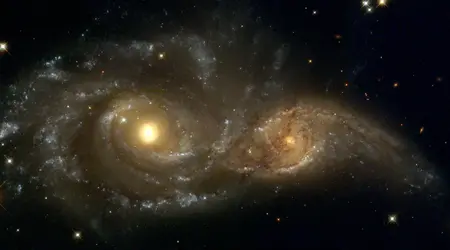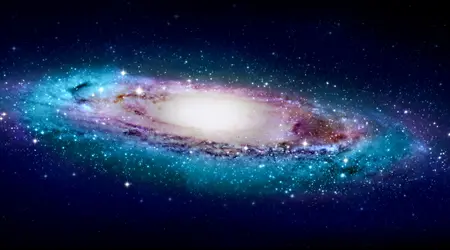Spiral Galaxies: Beauty and Mysteries of the Universe

Spiral galaxies are among the most captivating celestial structures in the cosmos, blending elegance with enigma.
Anúncios
These swirling giants, with their luminous arms and radiant cores, have fascinated astronomers and stargazers alike for centuries.
But beyond their aesthetic allure, spiral galaxies hold secrets that challenge our understanding of the universe.
From their intricate formation processes to their role in cosmic evolution, these galaxies are a testament to the complexity and grandeur of space.
The Anatomy of Spiral Galaxies: A Cosmic Masterpiece
Spiral galaxies are defined by their distinctive structure: a flat, rotating disk of stars, gas, and dust, with arms that spiral outward from a central bulge.
The Milky Way, our home galaxy, is a classic example of this type.
These arms are not static; they are dynamic regions of star formation, illuminated by the glow of young, hot stars.
The central bulge, on the other hand, is densely packed with older stars and often harbors a supermassive black hole.
One of the most intriguing aspects of spiral galaxies is their diversity.
While some, like the Milky Way, exhibit well-defined arms, others, such as flocculent spirals, have patchy, discontinuous arms.
This variation raises questions about the forces shaping these galaxies.
Gravitational interactions, magnetic fields, and dark matter all play a role, but the exact mechanisms remain a subject of ongoing research.
The Role of Dark Matter in Spiral Galaxies
Dark matter, the invisible substance that makes up about 27% of the universe, is a key player in the dynamics of spiral galaxies.
Without it, the outer regions of these galaxies would rotate more slowly than observed.
The presence of dark matter provides the additional gravitational pull needed to maintain their structure.
Recent studies, such as those conducted using the Hubble Space Telescope, have revealed that dark matter is distributed in a halo around spiral galaxies.
This halo extends far beyond the visible disk, influencing the motion of stars and gas.
Understanding the interplay between dark matter and visible matter is crucial for unraveling the mysteries of galaxy formation and evolution.
+ Dayson’s Star: What It Is and How It Influences Modern Astronomy
Star Formation in Spiral Arms: A Cosmic Nursery
The spiral arms of these galaxies are not just visually stunning; they are also hubs of stellar activity.
These regions are rich in molecular clouds, which serve as the birthplaces of new stars.
As these clouds collapse under their own gravity, they ignite the process of star formation, lighting up the arms with clusters of young stars.
Interestingly, the spiral arms themselves are not permanent structures.
They are density waves—regions of higher density that move through the galactic disk.
As gas and stars pass through these waves, they compress, triggering star formation.
This cyclical process ensures that spiral galaxies remain vibrant and dynamic throughout their lifetimes.

The Supermassive Black Hole Connection
At the heart of most spiral galaxies lies a supermassive black hole.
These colossal objects, with masses millions or even billions of times that of the Sun, exert a profound influence on their surroundings.
While they are often depicted as destructive forces, they also play a crucial role in regulating star formation and maintaining galactic stability.
For instance, the supermassive black hole in the Milky Way, known as Sagittarius A*, emits powerful jets of energy that can heat surrounding gas, preventing it from cooling and collapsing into new stars.
This feedback mechanism ensures that star formation occurs at a sustainable rate, preventing the galaxy from exhausting its gas supply too quickly.
The Evolution of Spiral Galaxies: A Cosmic Journey
Spiral galaxies have not always existed in their current form.
They are the product of billions of years of cosmic evolution, shaped by mergers, collisions, and the gradual accretion of gas. In the early universe, galaxies were smaller and more irregular.
Over time, gravitational interactions caused them to merge, forming larger, more structured systems.
One of the most significant challenges in studying spiral galaxies is understanding how they maintain their shape over billions of years.
Simulations suggest that the presence of a stable disk and the influence of dark matter are critical factors.
However, the exact processes remain a topic of debate among astronomers.
Spiral Galaxies and the Search for Extraterrestrial Life
The study of spiral galaxies is not just an academic pursuit; it also has profound implications for the search for extraterrestrial life.
The Milky Way alone is home to an estimated 100 billion stars, many of which host planets.
Spiral galaxies, with their abundant gas and active star formation, are likely to harbor a wide variety of planetary systems.
Recent discoveries, such as the TRAPPIST-1 system, have shown that rocky, Earth-like planets are common in our galaxy.
This raises the possibility that life could exist elsewhere in the universe.
By studying spiral galaxies, astronomers can identify the conditions necessary for life and narrow down the search for habitable worlds.
The Future of Spiral Galaxy Research
Advancements in technology are revolutionizing our understanding of spiral galaxies.
Instruments like the James Webb Space Telescope (JWST) and the upcoming Extremely Large Telescope (ELT) promise to provide unprecedented insights into their structure and evolution.
These tools will allow astronomers to peer deeper into the universe, observing galaxies as they were billions of years ago.
One area of particular interest is the study of galactic collisions.
When two spiral galaxies merge, they can form elliptical galaxies, which lack the distinctive spiral structure.
By observing these collisions, astronomers can gain valuable insights into the processes that shape galaxies.

++ The Search for Alien Life in the Most Distant Galaxies
Tables: Key Facts About Spiral Galaxies
Table 1: Characteristics of Spiral Galaxies
| Feature | Description |
|---|---|
| Structure | Flat disk with spiral arms and a central bulge |
| Star Formation | Active in spiral arms due to density waves |
| Dark Matter | Forms a halo that extends beyond the visible disk |
| Supermassive Black Hole | Present in the center, influencing star formation and galactic stability |
Table 2: Notable Spiral Galaxies
| Galaxy Name | Distance from Earth (light-years) | Notable Features |
|---|---|---|
| Milky Way | 0 (our galaxy) | Home to Earth and the Solar System |
| Andromeda (M31) | 2.537 million | Largest galaxy in the Local Group |
| Whirlpool (M51) | 23 million | Interacting with a smaller companion galaxy |
| Triangulum (M33) | 2.73 million | Third-largest galaxy in the Local Group |
Conclusion: A Universe of Wonder
Spiral galaxies are more than just beautiful cosmic objects; they are windows into the fundamental processes that govern the universe.
From their intricate structure to their role in cosmic evolution, these galaxies continue to captivate and challenge us.
As we delve deeper into their mysteries, we gain not only a greater understanding of the cosmos but also a deeper appreciation for our place within it.
The study of spiral galaxies reminds us that the universe is a dynamic, ever-changing entity, full of surprises and wonders waiting to be discovered.
Whether through the lens of a telescope or the simulations of a supercomputer, each new discovery brings us closer to unraveling the secrets of these celestial marvels.
